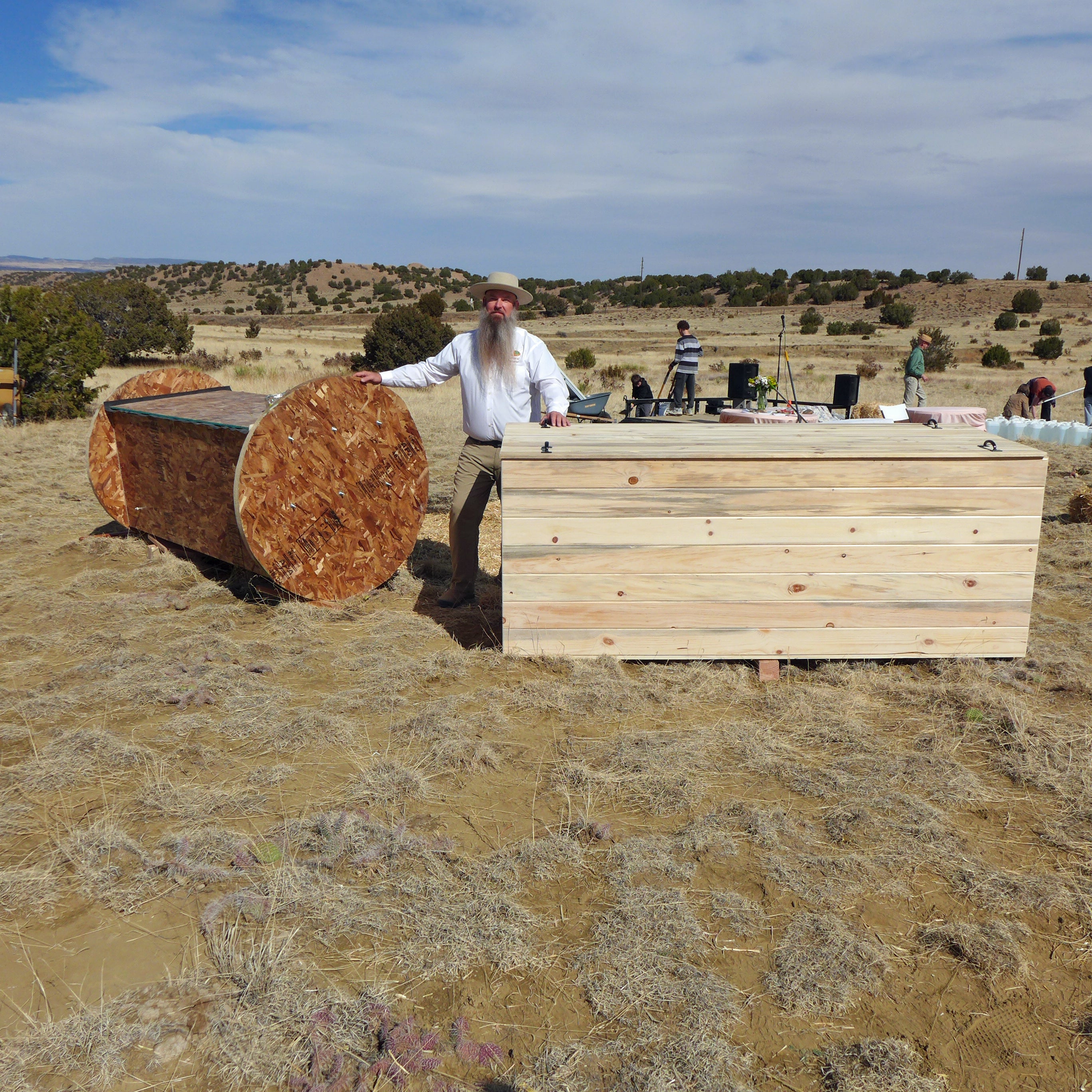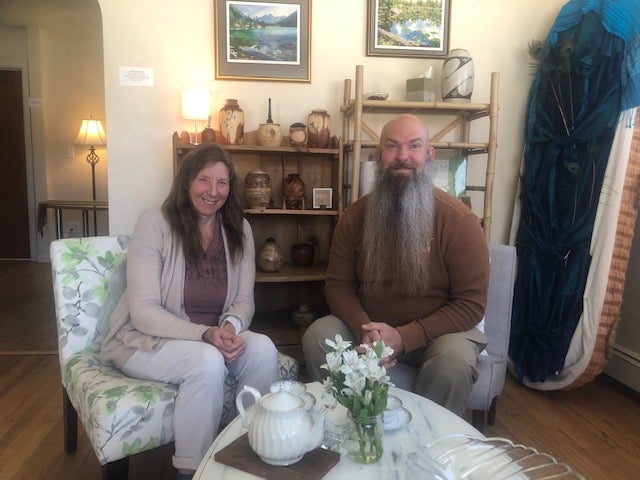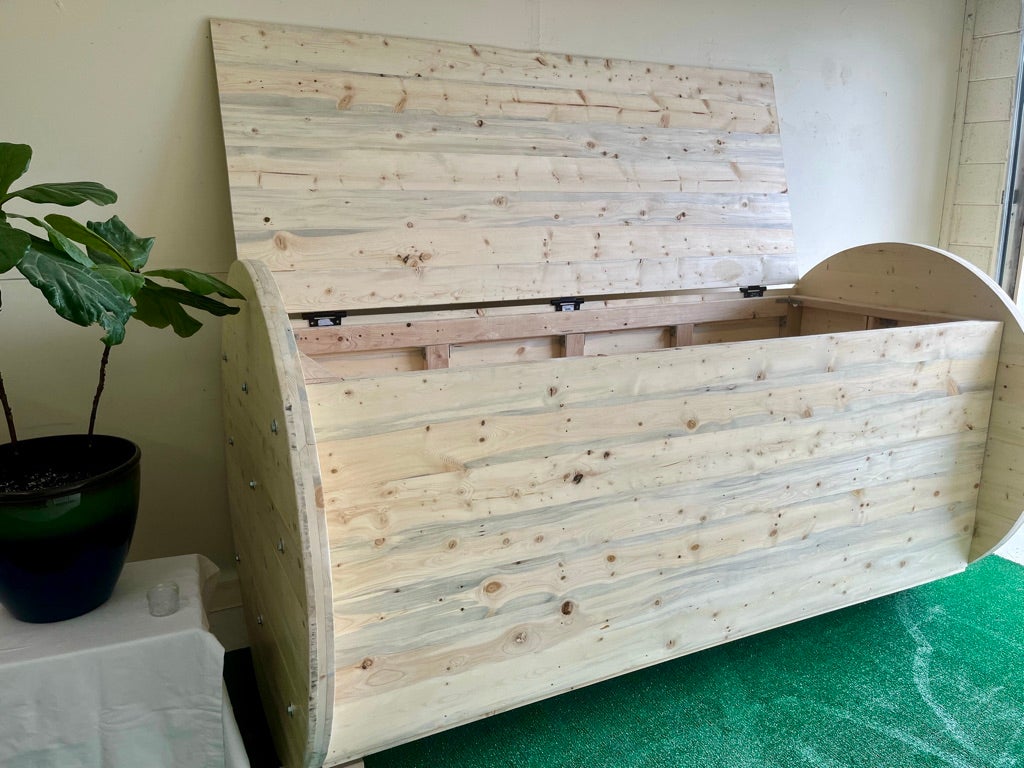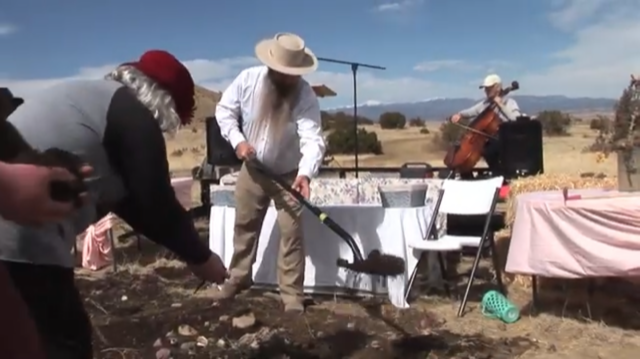
The sun finally peaks out from an overcast sky as a lone cellist plays at the Colorado Burial Preserve, the Rocky Mountains looming in the distant background. Mourners are spreading soil on a newly-made Earth altar dotted with rocks, plants and other “treasures” gathered earlier from the 65-acre preserve; the rich, dark soil is mixed with seeds in a natural attempt to restart the circle of life.
Because the soil itself also encompasses death – spread on the ground after months of being enriched in a specially-made vessel. That vessel composts human remains for people who choose this type of green, natural and newly-legal burial option after passing away.
Colorado in September became only the second US state to allow human body composting; Washington State pioneered the practice in May 2020. Oregon will allow it beginning this summer, and end-of-life industry professionals in other states are watching closely.
Based on what’s been seen so far in Colorado, the demand for human body composting is growing larger and more diverse.
“We are right at 20 bodies today who have selected this here in Colorado,” says Seth Viddal, who co-owns The Natural Funeral about a half-hour north of Denver in Lafayette – a rare home offering the service of natural reduction and the first to participate in a recent natural burial of a body fully composted in a specially-oufitted “chrysallis.”

“We are getting more people who are pre-planning for this, so they’re maybe not even in hospice yet – but they have just brought this form of disposition into their awareness, and they immediately want to shift and document their plans for their own death ... every month, it’s dozens more who are signing up for that.”
He adds that “it’s really ramping up exponentially with awareness.”
His co-owner, Karen Van Vuuren, tells The Independent that, earlier in the day, she was speaking with a university professor who teaches a death and dying course.
“As she was sharing with me, [she was] like, ‘Oh my God, all of my classes, they want to do something really natural when they die, [thinking] “It’s a no-brainer. Why would we choose anything but the natural?”
“Then the boomers are definitely more independent in their thinking and not just wanting to do what their parents did,” Ms Van Vuuren says. “Their parents are maybe less flexible in what they’re choosing, but it’s really going to shift through the generations.”
Mr Viddal says that “about a quarter of the people who have begun this process so far have come to us from out of state ... the demand is really going to call us to serve an expanded area.
“We don’t know what that looks like, but the demand is consistent, and the demand is growing.”
Practitioners of the evolving process concede that body composting dates back thousands of years, if not to the beginning of humanity; most people who select it – or those whose families choose it for them after their deaths – have been environmentally conscious throughout their lives, and the mode is in keeping with their belief systems.
“I see, every single day, people – who live their life as an activist, an environmentalist, a steward of the planet, a recycler, a composter – come to a funeral home and really have to ... make a sacrifice to their own values to pick what’s going to happen with their body when they die,” Mr Viddal says.

He adds: “Every body I bury in a cemetery, it’s taking up resources. It’s taking up space forever, in perpetuity. Some places, you’re being buried and that lawn will be watered and mowed and weeded for hundreds of years.
“In flame cremation, you’re consuming a great deal of energy. You’re creating pollution with the body, whether you want to or not. Whether you’re an environmentalist or not, your body pollutes when you used that method ... all of a sudden, there are these methods that use a tiny amount of energy, have absolutely no off-gassing, no pollution and, instead of having something toxic be the outcome of our body, a gift to the earth is an outcome of our body.”
As described by the Colorado state legislature website’s summary, last year it became legal for “human remains to be converted to soil using a container that accelerates the process of biological decomposition, also known as “natural reduction”.
“Natural reduction is added to the statutes that regulate funeral establishments, and this addition will result in the regulation of the natural reduction process,” the summary continues. “But the definitions of ‘cremation’ and ‘mortuary science practitioner’ are amended so that a practitioner of natural reduction is not regulated as a cremationist or mortuary science practitioner.”
The act prohibits a number of uses of the converted soil, such as: “Selling or offering to sell the soil; Commingling the soil of more than one person without the consent of the person or persons with the right of final disposition unless the soil is abandoned; Commingling the human remains of more than one person without the consent of the person or persons with the right of final disposition within the container wherein natural reduction produces soil; or Using the soil to grow food for human consumption.”
Mr Viddal and Ms Van Vuuren both lobbied Colorado’s government to legalise the process and are not remotely surprised by the increase in demand for it; both began working in the end-of-life business after being profoundly affected by personal experiences of loss.

“In a really compressed period of time, my uncle – who I caregave for at the end of his life – died, and then my mother died suddenly,” Mr Viddal, who worked in Air Force intelligence, real estate and contracting before completely switching to death care, tells The Independent. “My eldest aunt died; in the span of, really, about two years, also I had a younger brother ... who took his life by suicide.”
He adds that “the last tipping point, for me, was that about six years ago, I personally had a health situation.
“An intestine ruptured; I found myself in the hospital. I thought I was having a heart attack, and then I woke up as I went under the knife. I said goodbye to my wife and believed, as my eyes were closing, they would never open again.”
Ms Van Vuuren’s deep interest in the death process dates much further back. Born in Canada to Dutch and English parents, she grew up with a severely ill brother, three years her junior, who died when he was nine. The now-Colorado resident still remembers standing in the hallway in her mother’s native England when her father got the phone call from the hospital, where her little brother had been in the ICU for some time.
“My dad turned to us, my mother and I ... and said: ‘Dirk has gone. That’s life; we now just need to get on with it.’
“It was the Dutch, World War II [attitude],” Ms Van Vuuren tells The Independent. Her father “had been 14 when Holland was occupied and just had this stoic coping mechanism going on ... so it was a non-event, this death of a child, which had been anticipated for a very long time.”
She adds: “I didn’t cry – and that death of my brother really impacted me ... I didn’t grieve, and there was no ceremony, nothing to mark his life,” which had been marked by pain and suffering but included “joyful moments.”
“But there was no forum to share those,” she says. “And nobody talked, certainly, about what happens after death – like just an inquiry into the spiritual journey that might be happening.”

The Natural Funeral has come up with its own process for remains composting after studying best practice in Washington and conducting in-depth research. The length of natural reduction, from start to completion, varies depending on several factors, but the home is finding its conversion recipe is often finishing faster than the initial six months they expected.
“Our design was to create a vessel that mimics the exact dimensions of a green burial grave,” Mr Viddal tells The Independent, adding that it’s as old as humanity to “put bodies in the ground to do this” but “we’re going to put a body in a vessel to do this”.
“So let’s build a vessel that’s exactly three feet wide by three feet deep by seven feet long – and then, similar to composting technology that is rolled or agitated to mix the contents of the composting, let’s design our vesstel to have wheels on the end of it so that it can be mobile – so that the body can stay in the vessel, and we can in fact mix and turn the contents of the composting vessel without having to go into the vessel.
“Our vessel kind of looks like a spool with a rectangle in the middle that’s body-sized,” he adds, explaining that the “spool” is “made out of all-natural products, with two exceptions ... we have an insulated lining, because we want to make sure that we’re controlling the heat inside the vessel, and it’s hermetically sealed.
“We add a steady whisper flow of oxygen into the vessel, so 24 hours a day, a really low level of oxygen is fed into the vessel so that all the bacteria and fungi that are living have an aerobic, an oxygenated, environment to thrive in – and then there’s a constant exhaust so that air can escape.”
He adds: “We are monitoring this vessel 24 hours a day for temperature, moisture and oxygen levels ... the ingredients that go in are aged wood chips, aged alfalfa and aged straw. And then we put in the body, and then we layer [those three ingredients] in reverse.
“And then we go into the vessel with a very proprietary, very charged, very living blend of bacteria and fungi, and they’re specifically curated ... types of each bacteria and fungi – and over about the first 15 to 20 days, that vessel has heated up to an enormous temperature – and I mean typically 140 to 155 degrees [Fahrenheit].
“The requirement of the state of Colorado for natural reduction is that the vessel be contained; it has to happen at a crematory or a funeral home; the contents of the vessel have to reach 131 degrees for 72 continous hours.
“Our process ... triples that.”

The state regulations are designed to remove pathogens or chemicals from the body, including the remnants of pharmaceuticals, to make soil safe – but it also cannot be commercially sold or given to anywhere where it may be used on food crops.
The Natural Funeral gives families the option of a “laying in” ceremony as their loved one is interred in the chrysallis – and the first “laying out” ceremony took place last month at the aforementioned Colorado Burial Preserve.
But families are allowed to decide how they receive the soil and what they do with it; the process yields about a truckload of nutrient-rich dirt. Ms Van Vuuren says that, perhaps, her funeral home will offer a more regular commemorative ceremony for loved ones; her co-owner points out the farewell options are nearly endless.
“There’s a lot of cool versatility for this, because you don’t have to be buried at the cemetery,” he tells The Independent. “You could be buried or laid in to this process at your church or in your backyard or at the funeral home or at our crematory or at fill-in-the-blank ... a place that’s important to you.
“We can bring a chrysallis there; you gather your crew, we have this ceremony, we put the lid on together, and then, four to six months later, we’re letting you know that your loved one’s conversion is done and their soil is ready.”
Echoing the words of his co-owner, Mr Viddal calls the process a “no-brainer” for many environmentalists.
“In natural reduction, our body is converted biologically, through a life cycle, in living soil that will supplement crops forever,” he says. “Why not pick that?”







